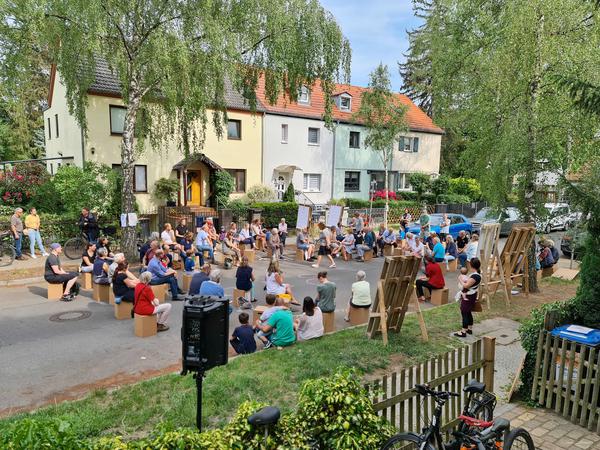The current urban development administration has no strategy for the climate-friendly conversion of the city – that means a newly founded, broad alliance of Berlin initiatives, environmental and tenants’ associations as well as individuals from architecture, urban planning and engineering. So that such a strategy for Berlin can finally be discussed seriously and concretely, you yourself have outlined the cornerstones for it. On Tuesday, the “Klimastadt Berlin 2030” alliance will present its six-page key issues paper, which was previously available to the Tagesspiegel.
“We don’t just want to complain, we want to make offers for discussion,” says architect Matthias Sauerbruch from the Sauerbruch Hutton architects’ office. That is why the alliance members have now worked in several workshops on a basis for discussion of exactly the strategy that they are missing from the Senate.
It is a very comprehensive approach: with climate resilience, the mobility turnaround and the construction turnaround, there are three topics at the top of the list that, in the narrower sense, come from the climate area. In addition, the alliance also outlines its vision for a cooperative city, for the common good and affordable housing, cultural freedom and the Berlin-Brandenburg metropolitan region.
It is therefore a very big question of how a climate-friendly change must be anchored socially, culturally and regionally in order to be supported by society at large. “Even the best organized and equipped city will only function if there is social peace. In this sense, cultural freedom is the basis for all success,” explains Sauerbruch.
We don’t just want to complain, we want to make offers for discussion.
Matthew SauerbruchArchitect
And so the promotion of experimental spaces and forums for citizen participation is just as much part of the demands as the unsealing of soil and the planting of 10,000 street trees per year, a moratorium on felling protected trees and the anchoring of large-scale roof and facade greening.
In the construction sector, the alliance aims to transform the state building code into a “conversion code”, a demolition moratorium and the legally binding reduction in CO₂ emissions in the construction sector, among other things by not only measuring the energy consumption of a house during operation, but also during construction is scrutinized.
Further demands are at least one model project per district as a cultural anchor point and temporary use of vacant properties for cultural projects. Last but not least, there should be more climate-friendly transport connections to Brandenburg, a regional timber construction initiative to strengthen a circular value chain and the implementation of a climate construction exhibition by Berlin and Brandenburg together.
negotiate conflicting goals
One thing is clear: the demand is enormous. However, the strategy for climate-friendly and social urban development is not yet complete with the key issues paper. “We are not against everything that comes from the Senate,” said Sauerbruch. “On the contrary, we would wish that the expertise of us experts would be used more.”
Finally, the alliance brings together diverse expertise from the relevant areas: The Bauhaus der Erde is part of the alliance, as are the Architects for Future Berlin, the BUND and the tenants’ association, the coalition of the independent scene, the Berlin Alliance for Sustainable Urban Development and KIEZconnect. In addition, several citizens’ initiatives and a range of architects such as Philipp Oswalt, Prager Richter Architects, Slavis Poczebutas, Eike Roswag-Klinge, Anna Bernegg, Sabine Müller, Theresa Keilhacker, Robertneun Architects and Christian Schöningh. The initiative goes back to the Berlin platform, which was founded about a year ago.

It was positive and almost a bit surprising how solution-oriented the discussions in the alliance were – although there are so many conflicting goals, and these are also represented by the very differently located members of the alliance. Example of densification: The Alliance for Sustainable Urban Development with its 33 neighborhood initiatives generally opposes densification and gentrification.
At the same time, densification in existing buildings is also an important measure to ensure that no new areas are sealed. “I think it’s a very positive signal how constructively we were able to negotiate the key points with each other in the alliance,” said Sauerbruch. “It’s also a sign of how great the need is.”
Participation on your own
Negotiating conflicts of interest and goals, consulting specialist expertise – what the alliance now wants to set in motion can almost be viewed as a kind of self-directed participatory process. A series of events on the individual aspects is being planned, says Sauerbruch. They seriously want to make the offer to advise the Senate with their own perspective, as a kind of sparring partner – even or especially although the current Senate administration may not be that interested in it.
Since the new legislative period, the senate administration has relied much less on external suggestions in the perception of the alliance members: “Participation plays an important role in the legacy of Ms. Lüscher and Ms. Lompscher, and the attempt to improve the climate and the future viability of the city instead.” For a year now, one has seen a top-down mentality with an emphasis on promoting reconstruction. For Sauerbruch, however, this is completely out of date: “It’s ‘Architects for past’.”
To home page
